
Are you looking for help with assistive listening devices?
Maybe:
- You work in a facility (school, business, etc) and have been asked to research assistive listening devices and what the law requires you to provide.
- Maybe a family member is showing signs of hearing loss. They turn the TV way up or ask you to “speak up” when you’re talking normally.
Maybe you’ve searched online for hearing assistance devices and been confused by the huge range of options out there.
Or maybe you’ve done some research but need to know about the pros and cons of, say, hearing loop systems versus FM. If this is starting to sound familiar, you’re in the right place…
This page cuts through the technical jargon of assistive listening devices and gives you a quick and easy guide to which system is best for you.
What Are Assistive Listening Systems?
Assistive listening devices (or systems) are tools that help people with hearing loss hear better by amplifying the sound and filtering out noise. This allows individuals with hearing loss to listen at the louder volumes they need, without disturbing others around them. All assistive systems:
- Minimize background noise (improve the signal-to-noise ratio, typically by 15-25 decibels)
- Counteract poor acoustics in a room such as echo
- Reduce the effect of distance between the sound source and ear
How Assistive Listening Systems Work
Whether you’re one person watching TV or designing an audio system for a large auditorium, all ALS systems work essentially the same way. They create an electronic link between the listener and the audio source (for example a movie, presentation, TV show, etc). The sound source is connected to a transmitter which encodes the sounds and sends them to receivers. This way, people can move naturally and not be ‘tied down’ to the audio source.
Systems vary in two ways:
- The type of technology used to transmit the audio signal; and
- The way the signal moves between the listener’s receiver and his/her auditory nerve. Standard headphones are the most common way of doing this. But some hearing aids and cochlear implants can also “tune in” to the audio feed.
Where are Assistive Listening Systems Required?
Many countries require assistive listening systems to be provided in venues where audible communication is critical to using the space. In the United States, these venues include classrooms, courtrooms, public meeting rooms, convention centers, and other public places.
Our compliance guides below will help you determine the exact requirements for your situation:

ADA Guide
Guide to assistive listening requirements under the Americans With Disabilities Act

International Guide
Guide to hearing support requirements and legislation around the world, including the EU, and UK.
The Seven Types of Assistive Listening System
1. FM Systems
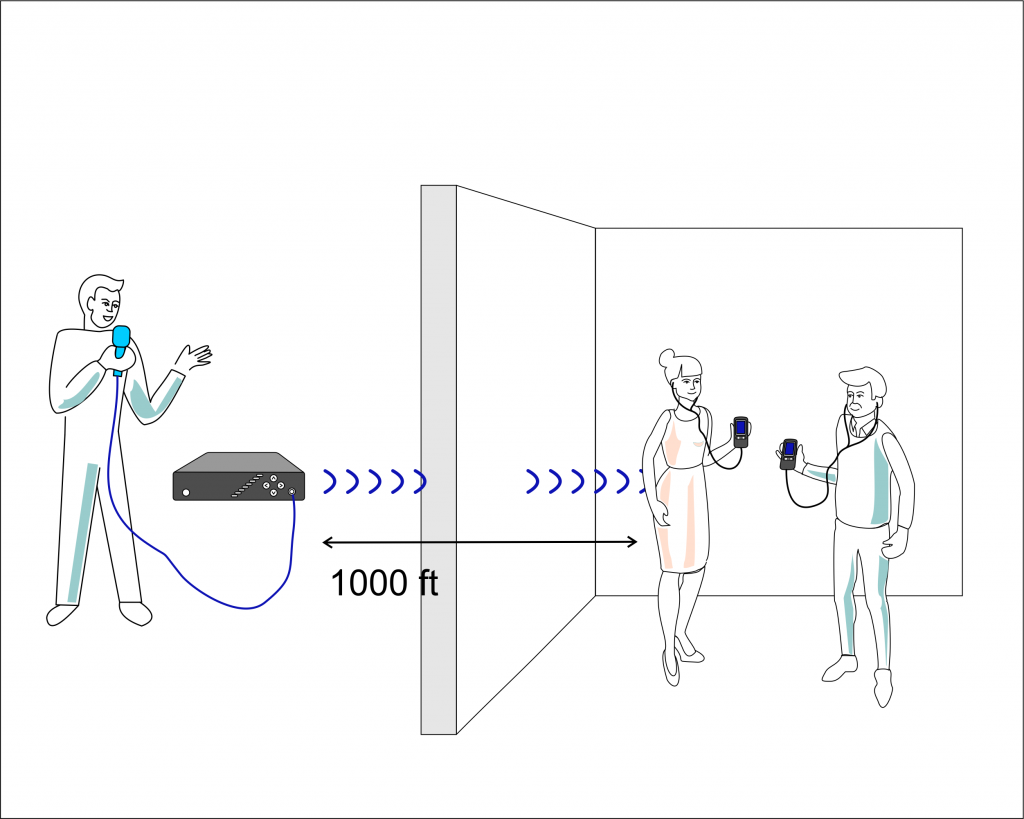 This is the same technology that powers the radio in your car. With FM systems, the source audio is connected to a transmitter, which sends the signal using FM radio waves to a receiver up to 1,000 feet away. From there, the receivers connect to listeners’ ears via standard 1/8″ headphone jacks. If you have a telecoil equipped hearing aid or cochlear implant, you can use a neckloop to bridge between an FM receiver and hearing aid.
This is the same technology that powers the radio in your car. With FM systems, the source audio is connected to a transmitter, which sends the signal using FM radio waves to a receiver up to 1,000 feet away. From there, the receivers connect to listeners’ ears via standard 1/8″ headphone jacks. If you have a telecoil equipped hearing aid or cochlear implant, you can use a neckloop to bridge between an FM receiver and hearing aid.
FM Basics
- FM signals penetrate walls, so listeners can be in another room.
- Cheaper to install and maintain.
- Reliable technology, used for decades.
- FM frequencies can be prone to interference in certain areas.
- Systems not usable in all countries due to spectrum restrictions.
- Not private: anyone with an FM scanner can listen.
- Not compatible with T-coil equipped hearing aids without a neckloop adapter.
2.Wi-Fi
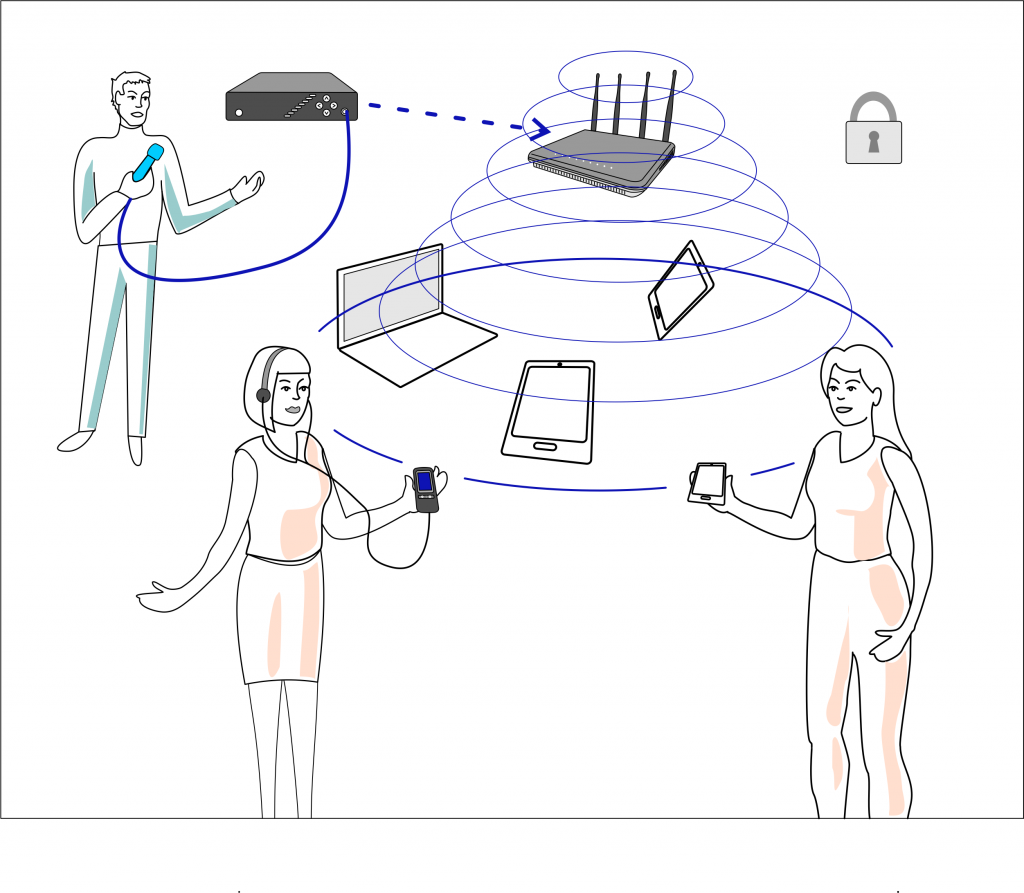 Wi-Fi systems use a digital signal making the audio quality higher than FM systems. One or more Wi-Fi routers broadcast the signal to all devices in range, creating a zone of coverage or “hotspot.” The audio feed can be secured with a password.
Wi-Fi systems use a digital signal making the audio quality higher than FM systems. One or more Wi-Fi routers broadcast the signal to all devices in range, creating a zone of coverage or “hotspot.” The audio feed can be secured with a password.
Wi-Fi Basics
- Listeners can use their personal phone or tablet which reduces the need to purchase receivers.
- Most users are familiar with connecting to Wi-Fi networks.
- If no encryption is set up, connection is almost seamless.
- Encryption can also be set up for added security.
- Cost effective option for large trade shows and combined indoor / outdoor roaming situations. Adding routers can easily expand the coverage area.
- Buildings with a lot of brick, concrete, or steel may block the Wi-Fi signal, creating dead zones or need for more routers.
- The more devices connected to a single router, the slower it becomes. Latency (sound delay) problems may arise with a large crowd.
3. Infrared (IR)
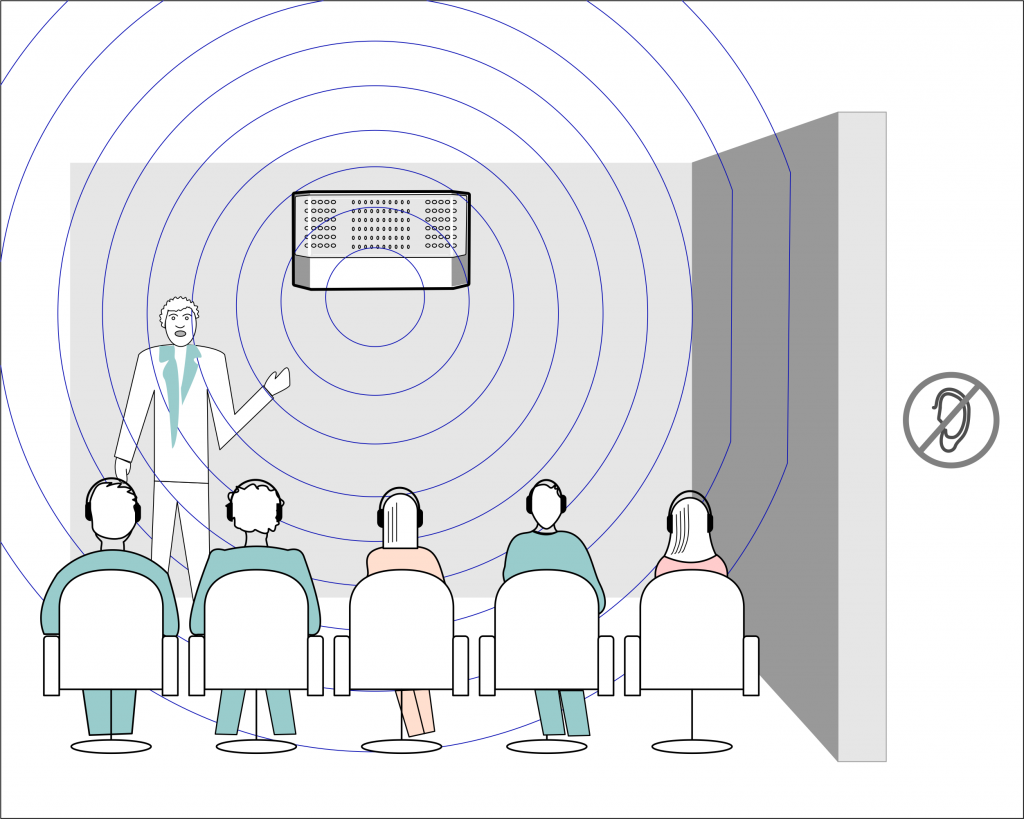 Infrared systems use an invisible beam of light to send the signal between the transmitter and the receivers. The same technology is used in TV remotes and some other household electronics. Infrared systems can be found in individual homes (sometimes worn around the neck with earphones plugged in) that will connect to the TV as well as in large facilities.
Infrared systems use an invisible beam of light to send the signal between the transmitter and the receivers. The same technology is used in TV remotes and some other household electronics. Infrared systems can be found in individual homes (sometimes worn around the neck with earphones plugged in) that will connect to the TV as well as in large facilities.
Infrared Basics
- Easy to deploy. The transmitter and receiver automatically connect as soon as they “see” each other.
- Effective over a large area. Some IR transmitters can cover a large open room.
- Transmission is private within room. The IR signal cannot penetrate through walls or other solid objects.
- Requires a direct line of sight
- IR emitters must be positioned high in a room to ensure coverage. Multiple emitters may be needed to fully cover a space.
4. Bluetooth
 Bluetooth is a short-range digital radio system found in modern smartphones, tablets, and computers. Like Wi-Fi, the devices have to be “paired” so unauthorized devices can be excluded from listening.
Bluetooth is a short-range digital radio system found in modern smartphones, tablets, and computers. Like Wi-Fi, the devices have to be “paired” so unauthorized devices can be excluded from listening.
Bluetooth Basics
- Many personal electronic devices have Bluetooth, so your listeners can use their own smartphone and earphones to listen.
- Because each device on the link has to be ‘paired’ it is secure. Only those who have connected via the Bluetooth link can hear.
- Short range. Top range is 100 meters (328 feet). Compare with FM systems with a max range of 1000 feet.
- Bluetooth devices must be paired to the source. Devices have different steps for doing this, making it hard to provide “tech support” to a group of people with many different types of phones.
5. Hearing Loops
 Hearing Loops (AKA Induction Loops / Telecoil Loops,) are commonly used in auditoriums, theatres, and other facilities. They transmit directly to hearing aids via magnetic field. The “loop” refers to a wire that is installed along the perimeter of a room, usually under the floor. When a loop system is active, individuals with hearing aids that have a T-coil setting, can listen to the audio signal directly into their hearing aids by activating the “T” setting. What about people with no hearing aids? They can also tune into the system using a neck loop, which is an antenna that connects to a receiver.
Hearing Loops (AKA Induction Loops / Telecoil Loops,) are commonly used in auditoriums, theatres, and other facilities. They transmit directly to hearing aids via magnetic field. The “loop” refers to a wire that is installed along the perimeter of a room, usually under the floor. When a loop system is active, individuals with hearing aids that have a T-coil setting, can listen to the audio signal directly into their hearing aids by activating the “T” setting. What about people with no hearing aids? They can also tune into the system using a neck loop, which is an antenna that connects to a receiver.
Hearing Loop Basics
- Cuts out unwanted background noise.
- No need to use a receiver / headset (for those with T-coil hearing aids).
- Inconspicuous.
- Any number of users can use the system.
- Only those “in the loop’ can listen. Only those with the telecom enabled hearing aid will benefit without a neckloop accessory.
- Requires a large-scale renovation of the facility (usually ripping up part of the floor) to retrofit, ideal for installation in a new facility.
6. Digital
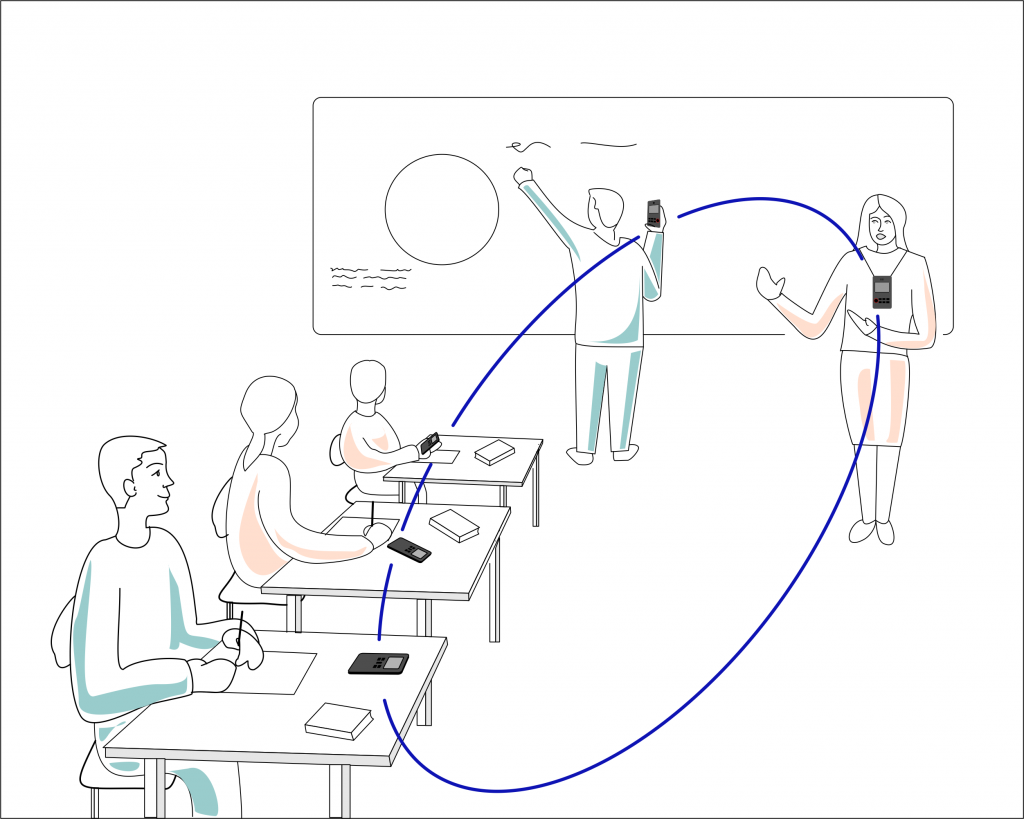 Digital assistive listening systems (such as the DigiWave line of products from Williams Sound) operate similar to FM systems. The only difference is that they use a different part of the radio spectrum and encode their transmission using digital data rather than an analogue format.
Digital assistive listening systems (such as the DigiWave line of products from Williams Sound) operate similar to FM systems. The only difference is that they use a different part of the radio spectrum and encode their transmission using digital data rather than an analogue format.
Digital Basics
- Best audio quality.
- Digitally encrypted communication to prevent unauthorized listeners.
- Highly light weight and portable.
- No installation costs or technical assistance needed to operate.
- Extended battery life.
- Systems can be easily expanded to add more listeners.
- No need for listeners to have a hearing aid or cochlear implant.
- Can be easily expanded to offer multi channels (for example combined with language interpretation equipment).
- Higher cost.
7. Personal / Home Assistive Listening Devices
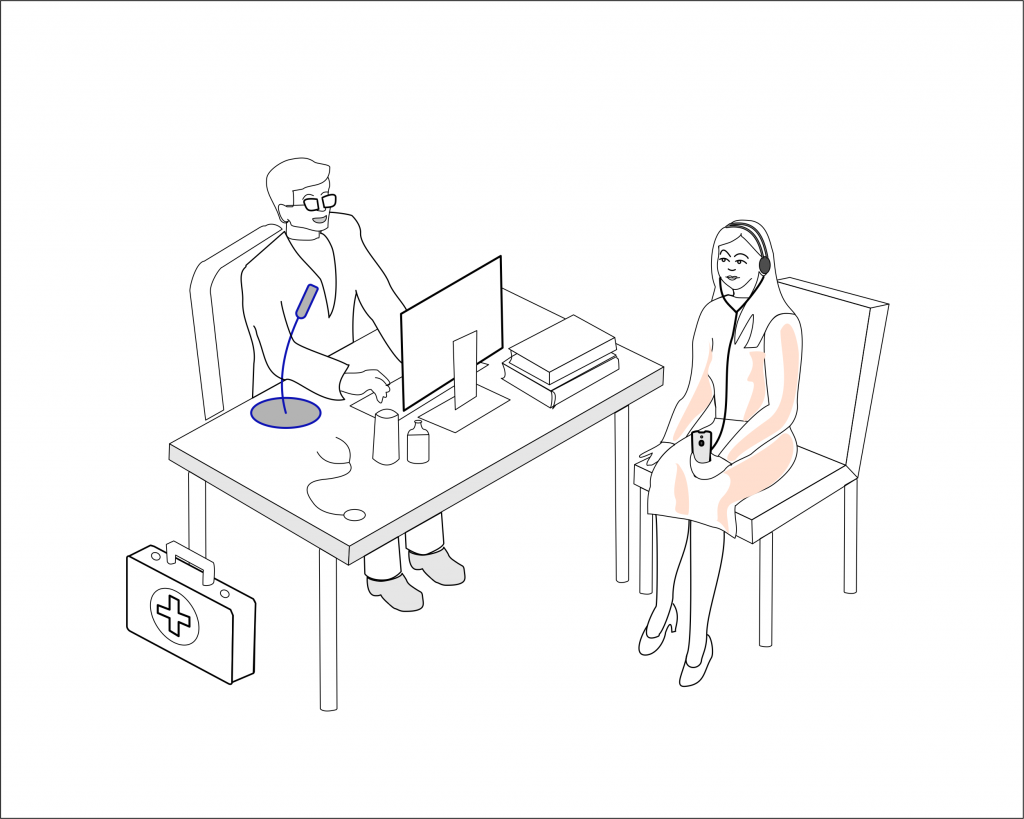 Are you looking for a personal amplifier to compensate for hearing loss at home? To help with watching TV or hearing conversations? These are meant to mimic the effects of a hearing aid or cochlear implant, They pick up the sound in the immediate vicinity, reduce background noise, and transmit it to the listener’s ear with a minimum of signal loss. Unlike the other hearing devices discussed above, they combine the input (mic) with the amplifier and output in a single easy-to-use unit.
Are you looking for a personal amplifier to compensate for hearing loss at home? To help with watching TV or hearing conversations? These are meant to mimic the effects of a hearing aid or cochlear implant, They pick up the sound in the immediate vicinity, reduce background noise, and transmit it to the listener’s ear with a minimum of signal loss. Unlike the other hearing devices discussed above, they combine the input (mic) with the amplifier and output in a single easy-to-use unit.
Personal Device Basics
- Simple to use, self-contained unit.
- Great for use at home, travel, or facilities where listening devices are not provided.
- No setup costs or configuration.
- Great option for when hearing aids are not a workable option; can be used only when needed (for example noisy public places).
- Microphone picks up all ambient sounds, and may also amplify unwanted background sounds.
Questions To Help Choose a System
With so many options, selecting the right equipment can be a bit daunting. We’ve helped
But if you’re more the “do-it-yourself” type, answering these should point you in the right direction:
- How many listeners will your system need to support?
- What are the applicable laws in my area with regard to the physically challenged and the hard of hearing?
- Will you be traveling to other countries while using the equipment?
- Will the installation be done as part of a building renovation? Or in an already-built space?

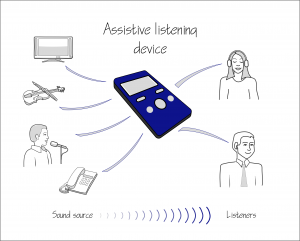
 Hi – I’m Will and I started this company to help you find the best assistive listening equipment for you.
Hi – I’m Will and I started this company to help you find the best assistive listening equipment for you.